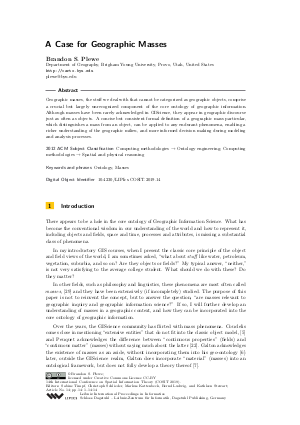A Case for Geographic Masses
Author Brandon S. Plewe
-
Part of:
Volume:
14th International Conference on Spatial Information Theory (COSIT 2019)
Part of: Series: Leibniz International Proceedings in Informatics (LIPIcs)
Part of: Conference: Conference on Spatial Information Theory (COSIT) - License:
 Creative Commons Attribution 3.0 Unported license
Creative Commons Attribution 3.0 Unported license
- Publication Date: 2019-09-03
File

PDF
LIPIcs.COSIT.2019.14.pdf
- Filesize: 2.56 MB
- 14 pages
Document Identifiers
Subject Classification
ACM Subject Classification
- Computing methodologies → Ontology engineering
- Computing methodologies → Spatial and physical reasoning
Keywords
- Ontology
- Masses
Metrics
- Access Statistics
-
Total Accesses (updated on a weekly basis)
0Document
0Metadata
Abstract
Geographic masses, the stuff we deal with that cannot be categorized as geographic objects, comprise a crucial but largely unrecognized component of the core ontology of geographic information. Although masses have been rarely acknowledged in GIScience, they appear in geographic discourse just as often as objects. A concise but consistent formal definition of a geographic mass particular, which distinguishes a mass from an object, can be applied to any endurant phenomena, enabling a richer understanding of the geographic milieu, and more informed decision making during modeling and analysis processes.
Cite As Get BibTex
Brandon S. Plewe. A Case for Geographic Masses. In 14th International Conference on Spatial Information Theory (COSIT 2019). Leibniz International Proceedings in Informatics (LIPIcs), Volume 142, pp. 14:1-14:14, Schloss Dagstuhl – Leibniz-Zentrum für Informatik (2019)
https://doi.org/10.4230/LIPIcs.COSIT.2019.14
BibTex
@InProceedings{plewe:LIPIcs.COSIT.2019.14,
author = {Plewe, Brandon S.},
title = {{A Case for Geographic Masses}},
booktitle = {14th International Conference on Spatial Information Theory (COSIT 2019)},
pages = {14:1--14:14},
series = {Leibniz International Proceedings in Informatics (LIPIcs)},
ISBN = {978-3-95977-115-3},
ISSN = {1868-8969},
year = {2019},
volume = {142},
editor = {Timpf, Sabine and Schlieder, Christoph and Kattenbeck, Markus and Ludwig, Bernd and Stewart, Kathleen},
publisher = {Schloss Dagstuhl -- Leibniz-Zentrum f{\"u}r Informatik},
address = {Dagstuhl, Germany},
URL = {https://drops.dagstuhl.de/entities/document/10.4230/LIPIcs.COSIT.2019.14},
URN = {urn:nbn:de:0030-drops-111062},
doi = {10.4230/LIPIcs.COSIT.2019.14},
annote = {Keywords: Ontology, Masses}
}
Author Details
References
- Oxford English Dictionary, 3rd Edition, 2000. URL: http://oed.com/.
-
Harry C. Bunt. Mass Terms and Model-theoretic Semantics, volume 42 of Cambridge Studies in Linguistics. Cambridge University Press, 1985.

-
Roberto Casati and Achille C Varzi. Parts and places: The structures of spatial representation. MIT Press, 1999.

- Vere C Chappell. Stuff and things. In Proceedings of the Aristotelian Society, volume 71, pages 61-76. JSTOR, 1970-1971. URL: https://www.jstor.org/stable/4544801.
- Helen Couclelis. A Typology of Geographic Entities with Ill-defined Boundaries. In Peter A. Burrough and Andrew U. Frank, editors, Geographic Objects with Indeterminate Boundaries, pages 45-55. London: Taylor and Francis, 1996. URL: https://books.google.com/books?id=r-2i_hKbx9gC&pg=PA45.
- Anthony Galton. Desiderata for a Spatio-temporal Geo-ontology. In Werner Kuhn, Michael F. Worboys, and Sabine Timpf, editors, Spatial Information Theory: Foundations of Geographic Information Science (COSIT 2003), pages 1-12. Berlin: Springer, 2003. URL: https://doi.org/10.1007/978-3-540-39923-0_1.
- Anthony Galton and Riichiro Mizoguchi. The Water Falls but the Waterfall does not Fall: New perspectives on Objects, Process and Events. Applied Ontology, 4(2):71-107, 2009. URL: https://pdfs.semanticscholar.org/309d/2ba88406bff2f545eec8086d20673287070f.pdf.
-
A. Gangemi, N. Guarino, C. Masolo, A. Oltramari, and L. Schneider. Sweetening Ontologies with DOLCE. In A. Gómez-Pére and V.R. Benjamins, editors, Knowledge Engineering and Knowledge Management: Ontologies and the Semantic Web, 13th International Conference, EKAW 2002, pages 166-181. Berlin: Springer Verlag, 2002.

- Brendan S Gillon. Towards a common semantics for English count and mass nouns. Linguistics and philosophy, 15(6):597-639, 1992. URL: https://doi.org/10.1007/BF00628112.
-
Nelson Goodman. The Structure of Appearance, 3rd Edition, volume 53 of Boston Studies in the Philosophy of Science. Dordrecht: D. Reidel, 1951/1977.

- Jorge J.E. Gracia. Metaphysics and Its Task: The Search for the Categorial Foundation of Knowledge. State University of New York Press, 1999. URL: https://books.google.com/books?id=_5JQKKsZIgUC.
- Richard E. Grandy. Stuff and things. Synthese, 21(3/4):479-485, 1975. URL: https://doi.org/10.1007/978-1-4020-4110-5_15.
-
Heinrich Herre. Persistence, change, and the integration of objects and processes in GFO. In Vesselin Petrov and Adam C. Scarfe, editors, Dynamic Being: Essays in Process-Relational Ontology, pages 337-354. Cambridge Scholar Publishing, 2015.

- Heinrich Herre. Formal Ontology-A New Discipline Between Philosophy, Formal Logic, and Artificial Intelligence, 2016. URL: https://pdfs.semanticscholar.org/62af/ab4d0412df9519c1e7004ed3f5fc6fc59096.pdf.
-
Ray Jackendoff. Parts and Boundaries. In B. Levin and S. Pinker, editors, Lexical and Conceptual Semantics, pages 9-45. Cambridge, MA: Blackwell, 1992.

-
George Lakoff. Women, Fire, and Dangerous Things: What Categories Reveal about the Mind. University of Chicago Press, 1987.

-
Henry Laycock. Words without Objects: Semantics, Ontology, and Logic for Non-Singularity. Oxford University Press, 2006.

- Friederike Moltmann. Part structures, integrity, and the mass-count distinction. Synthese, 116:75-111, 1998. URL: https://doi.org/10.1023/A:1005046308299.
- David Nicolas. Mass nouns and plural logic. Linguistics and philosophy, 31(2):211-244, 2008. URL: https://doi.org/10.1007/s10988-008-9033-2.
-
Alex Oliver and Timothy Smiley. Plural Logic: Revised and Enlarged. Oxford University Press, 2013.

- Adam Pease. Suggested Upper Merged Ontology (SUMO). URL: http://www.adampease.org/OP/.
- Donna Peuquet, Barry Smith, and B. Brogaard, editors. The Ontology of Fields: Report of a Specialist Meeting held under the auspices of the Varenius Project. Santa Barbara, CA: National Center for Geographic Information and Analysis, 1999. URL: https://escholarship.org/uc/item/33d7c1pt.
- Roberto Poli. Ontology: The Categorial Stance. In Roberto Poli and Johanna Seibt, editors, Theory and Applications of Ontology: Philosophical Perspectives, pages 1-22. Springer, 2010. URL: https://doi.org/10.1007/978-90-481-8845-1_1.
-
Willard V.O. Quine. Word and object: An inquiry into the linguistic mechanisms of objective reference. John Wiley, 1960.

- Johanna Seibt. Particulars. In Roberto Poli and Johanna Seibt, editors, Theory and Applications of Ontology: Philosophical Perspectives, pages 23-55. Springer, 2010. URL: https://doi.org/10.1007/978-90-481-8845-1_2.
-
Peter M. Simons. Parts: a study in Ontology. Oxford University Press, 1987.

- Barry Smith and Pierre Grenon. BFO: Basic Formal Ontology, 2002. URL: http://basic-formal-ontology.org/.
- Barry Smith and David Mark. Geographical Categories: an Ontological Investigation. International Journal of Geographical Information Science, 15(7):591-612, 2001. URL: https://doi.org/10.1080/13658810110061199.
- Mark Steen. The Metaphysics of Mass Expressions. In Edward N. Zalta, editor, Stanford Encyclopedia of Philosophy. Stanford University, 2012. URL: http://plato.stanford.edu/entries/metaphysics-massexpress/.
-
Peter F. Strawson. Individuals. London: Methuen, 1959.

